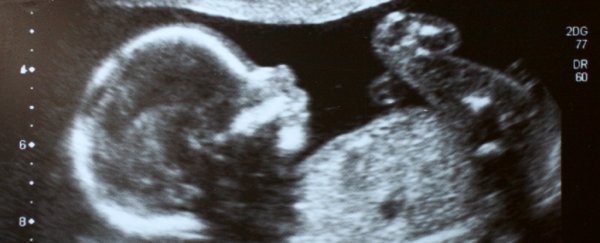When babies kick in the womb, those forceful little jolts are an amazing illustration of the energy and power of tiny, developing bodies - but they're also a bit strange, when you pause to think about it.
Now, new research has weighed in, trying to explain what these foetal movements could represent.
In a new study examining the brain activity of 19 newborn babies, researchers in the UK found that brainwaves corresponding to limb movements during sleep might help the infants form crucial awareness of their bodies and immediate surroundings.
"Spontaneous movement and consequent feedback from the environment during the early developmental period are known to be necessary for proper brain mapping in animals such as rats," explains neuroscientist Lorenzo Fabrizi from University College London.
"Here we showed that this may be true in humans too."
 (househark/YouTube)
(househark/YouTube)
In the study, Fabrizi's team used non-invasive electroencephalography (EEG) sensors to measure the brainwaves of 19 two-day-old infants.
Some of the babies were premature births, with the group ultimately reflecting a range of between 31–42 corrected gestational weeks (the cumulative period of their gestation and weeks since being born).
Animal studies show that isolated limb movements from neonates are a hallmark of sensory development and processing in young mammals, evidenced by neural patterns called alpha-beta oscillations in the somatic nervous system.
The thinking is, these oscillations help very young animals to map physical layout of the body, but up until now, it wasn't clear quite when this developmental period occurred.
With their two-day-old cohort – who, in terms of corrected gestational age, actually signified a range of developmental ages – the researchers were able to narrow this down.
During active, rapid eye movement (REM) sleep, the researchers found the activity of the alpha-beta brainwave patterns diminished in the older babies (closer or at full-term), being strongest in the youngest, most premature infants.
"This suggests that movement-related alpha-beta oscillations fulfil a role throughout the equivalent of the third trimester of gestation, which is exhausted at full-term age even when the movements themselves persist," the authors explain in their paper.
In other words, occasional jerky limb movements during active sleep might be seen in older babies (and even adults!), but the sensory development corresponding with the sudden kicks and punches only takes place in the very, very young, and disappears by the time babies are just a few weeks old.
The kinds of brainwaves the researchers are talking about fire in the corresponding hemisphere of the brain. For instance, when a premature baby does a sudden kick or punch with their right hand or foot during REM sleep, the oscillations can be observed in the left hemisphere of their brain.
Aside from telling us more about how this neural circuitry operates, the findings are a reminder of how important it is to to protect sleep in young children, especially infants born before full-term, whose REM sleep is vital for developing this sensory, body-mapping awareness.
"It is already routine for infants to be 'nested' in their cots – this allows them to 'feel' a surface when their limbs kick, as if they were still inside the womb," says the first author of the study, research clinical physiologist Kimberley Whitehead.
"As the movements we observed occur during sleep, our results support other studies which indicate that sleep should be protected in newborns, for example by minimising the disturbance associated with necessary medical procedures."
Only a small number of children took part in the study – and the researchers acknowledge that infants who naturally move more than others during sleep could skew the results.
But the research also doesn't end there. The team's newest work – not yet published – examines how subsequent sensory development takes place after the first mapping processes are conducted.
"These early patterns [developed usually in utero] lay out the pathways on which then experience after birth can work on to refine the initial map," Whitehead told Live Science.
Baby steps, as it were.
The findings are reported in Scientific Reports.
